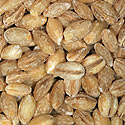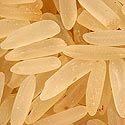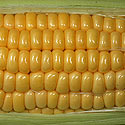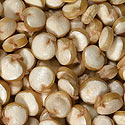|
Food and drink biodiversity:
Grains
Almost all grain plants are
grasses (Poaceae) but there are one or
two exceptions such as buckwheat, which falls in the
rhubarb family (Polygonaceae).
Grains are fruits with the dry covering of the fruit's pericarp adhering as a
thin layer to the outside of the seed.
Domestication of wild grasses took place in a number of different regions round
the world:
-
Near East.
Barley and
wheat were domesticated over
9000 years ago. Rye
was initially a weed of these crops and through being harvested together
with these crops, was gradually domesticated and became a grain crop in its
own right.
-
Asia.
Rice,
Common millet and
Foxtail millet were
domesticated in various parts of this region at least 7000 years ago.
-
Central America (Mexico).
Maize was domesticated about
7000 years ago.
-
Africa.
African finger millet
was domesticated more than 5000 years ago,
Pearl millet 4000
years ago and Sorghum at
least 3000 years ago.
-
Europe.
Oats were domesticated
about 4500 years ago.
Once these various regions started communicating with one
another via human population dispersion and trade, the distribution of crop
species changed substantially. Wheat became the dominant grain crop overall and
is now grown globally mainly in warm temperate regions. Once maize was
introduced to Africa in the 16th century it rapidly usurped Sorghum as the
dominant staple crop (except in the drier regions). Maize also become a dominant
crop in North America. Rice growing did spread to other parts of the world, but
over 90% of rice production still remains in Asia, its region of origin.
In all cases of grass domestication for grain production,
the domestication involved selection of plants that kept their seed on the plant
(non-shattering), rather than releasing them haphazardly. This selection process
automatically came into play through people only harvesting seeds that were
still on the plant because seeds that had fallen from the plant were not visible
and hence unavailable. While some of the seeds harvested from plants were
kept for consumption, others were planted and thus over a number of generations
there was active selection of these non-shattering seeds. There was also
selection for plants that had large seeds, those that had more seeds per plant,
and for seed that dehusked easily.
There are still some species of wild grasses in southern
Africa that are harvested for their grain and the more important species are
listed below.
A grain or kernel on a grass plant is botanically a
complete fruit with a single seed whose ovary-derived layer is thin and dry.
Grains domesticated out of Africa
Avena sativa (Oats)
Oat plants were domesticated in Europe, as late as 3000 to 4000 years ago.
Oats is a healthy cereal because it contains high protein levels,
antioxidants and a substance that reduces blood cholestrol, blood pressure
and blood sugar levels. |
|
Coix lachryma-jobi
(Job's tears) This species has teardrop-like false fruits
situated at the base of the spikelet, which besides being used as beads in
necklaces, are also used for food. Domestication possibly occurred in the
Philippines. The grain is eaten whole or ground into flour used for baking
or in wine and beer production. It contains at least 50% starch, 14% protein
and 6% fat. |
|
|
Hordeum vulgare (Barley)Domesticated more than
9750 years
ago in the Near East. It is a nutritious grain with nutrients concentrated mainly
near the bran - hence the more the grain is milled the less nutritious it
becomes. Barley absorbs the flavours of the liquid it is cooked in
and hence is a good addition to soups and stews. It can also be eaten with
vegetables as a vegetarian meal with a reasonably high protein content. It is
often used as a substitute for rice. The main use of barley in southern Africa is for malting
to produce beer. |
 |
Oryza sativa (Rice) Rice was domesticated in Asia at least
7000 years ago.
Over 90% of world rice production is in Asia where the monsoon rains favour
paddy rice, which needs to grow in wet conditions. Rice is a staple food among many people in southern Africa
but is derived almost exclusively from Asian imports and is rarely grown in this
region. In Asia, rice is not only used in eating but also used for making
alcoholic drinks such as saki in Japan. |
 |
Panicum miliaceum
(Common millet) Common millet originated in Central Asia and it was
probably in this region, or perhaps China that it was domesticated, about
7000 years ago. Worldwide, Common millet is grown mainly in eastern and
central Asia, India and the Middle East. It is cultivated to a
limited extent in southern Africa. Dehusked grains are cooked like rice or
ground up and used for porridge. It is also grown for bird seed and animal
feed. |
|
Secale cereale (Rye) Rye is thought to have originated in eastern Turkey and
Armenia and initially became domesticated as a weed in wheat and barley crops.
It became a favoured crop in north temperate regions of Europe because it is
more cold tolerant than wheat. Rye has a low gluten content, has high water
retention properties and is used for making bread, crisp bread and in the
manufacture of some alcoholic spirits. |
|
Setaria italica
(Foxtail millet) Setaria italica was domesticated from the wild
Setaria viridis in East Asia more than 7000 years ago, during the
Neolithic period. Foxtail millet is nowadays a minor crop in SE Europe,
parts of Asia (especially India, China and Japan) and North Africa. In southern
Africa it is grown to a minor extent for human consumption, and on the Springbok
Flats it is grown commercially for producing bird seed. |
|
|
Triticum sp. (Wheat)
The two main types of wheat used these days are Durum wheat Triticum
turgidum and bread wheat Triticum aestivum. Durum wheat is a variety of Emma
wheat, the latter of which was the first type of wheat to be domesticated,
about 9000 years ago. Bread wheat is derived from the hybridization of Emma
wheat with the wild grass Aegilops squarrosa, which happened about 6700
years ago. Wheat is now the world's major crop in terms of food production. |
|
|
Zea mays (Maize)Maize was domesticated in Mexico about
7000 years ago and by the time Columbus
arrived in the New World, there were already many varieties. It was introduced
to Africa in the 16th century and over time came to replace
sorghum as the staple
food in all but the drier areas. |
 |
Grains domesticated in Africa
Eleusine coracana
(African finger millet) This species was domesticated in Africa from the wild form
Eleusine africana more that 5000 years ago. In southen
Africa it has been cultivated since the Iron Age. Within southern Africa, African finger millet is favoured
as a source of malt for brewing of beer because of the sweetness it gives the
malt. Further north in Africa it is used more commonly as a source of food such
as porridge (e.g. in Zambia and Malawi). |
|
Pennisetum glaucum
(Pearl millet, Bulrush millet) Domesticated
in Africa about 4000 years ago. Within southern Africa it is the staple
cereal in northern Namibia, the Okavango region of Botswana, and southern
Angola. One of the main attractions of this species is that it can be
cultivated in hot, drought prone areas with unreliable rainfall and hence is
the crop of choice is regions experiencing such conditions. |
|
Sorghum bicolor
(Sorghum) Sorghum is an indigenous African crop domesticated more
than 3000 years ago that grows well
in areas that experience droughts. To a large extent it has been replaced by
maize (which originates from South America) but it is still grown quite
extensively in southern Africa both as a subsistence crop, and commercially. It
has a number of uses including beer making and for porridge, but the commercial
crop is used mainly for stock feed.
|
|
Wild grains eaten in southern Africa
Eragrostis In southern Africa in times of famine, seeds are sometimes
harvested from wild plants of Eragrostis chloromelas, Eragrostis cilianensis,
Eragrostis curvula and Eragrostis plana and used in making bread and
beer. |
|
Setaria sphacelata
(Common bristle grass) In KwaZulu-Natal, seeds from this wild grass are harvested
in times of famine. They are boiled before grinding, evidently to eliminate
toxic substances.
|
|
|
Setaria verticillata
(Bur-bristle grass)
The Topnaar people in Namibia harvest the
wild seeds and grind them up for making porridge. They also use the leaves
for weaving hats. In South Africa the seeds are used to produce a malt for
beer making. |
|
|
Stipagrostis
brevifolia (Bushmangrass)
Seeds are eaten by the San people.
|
|
Stipagrostis
uniplumis (Large bushmangrass) Seeds are eaten by the San people.
|
|
|
Urochloa
mosambicensis (Bushveld signal grass)
Often used as a cereal in rural areas in southern Africa.
Seed heads of wild plants are picked when slightly green (hence avoiding the
problem of seeds being shed before harvesting). When the heads have dried, the
spikelets are rubbed from the stalks and ground into a meal that is used in
making porridge.
|
|
Grains that are not
grasses
|
Chenopodium quinoa
(Quinoa)
An annual herb growing to 2 m in height that originates
from South America. It was the staple grain of the Inca people, with
archaeological remains dating back to 5000 BC. In recent years it has become
popular as a health food because it has a high protein content (14-18%), it
is gluten-free and it is rich in lysine and methionine. Seeds need to be
first soaked, washed and rubbed to remove bitter substances (saponins) in
the seed coat. Seeds can be cooked and eaten, or roasted and ground into
flour that can be used for making pastas, pancakes and other foods. |
 |
Fagopyrum esculentum
(Buckwheat) Buckwheat is not a grass but a
member of the rhubarb family (Polygonaceae).
It contains high quality protein and it reduces blood cholesterol. It is grown to some extent in southern Africa as a
fodder crop but is becoming increasingly popular as a health food. |
|
Publications
-
Anon. 2002. Encyclopedia of Foods. A Guide
to Healthy Nutrition. Academic Press, San Diego, California.
-
Harlan, J.R. 1995. The living fields - our
agricultural heritage. Cambridge University Press, Cambridge.
- McGee, H. 1991 (first published 1984). On
Food and Cooking. The Science and Lore of the Kitchen. Harper Collins,
London.
-
Sauer, J.D. 1993. Historical geography of
crop plants - a select roster. CRC Press, Boca Raton, Florida.
-
van Wyk, B.-E. & Gericke, N. 2000. People's
Plants. A Guide to Useful Plants of Southern Africa. Briza Publications,
Pretoria.
-
Zohary, D. & Hopf, M. 1993. Domestication
of plants in the old World - The origin and spread of cultivated plants in
West Asia, Europe, and the Nile Valley. Clarendon Press, Oxford.
|
